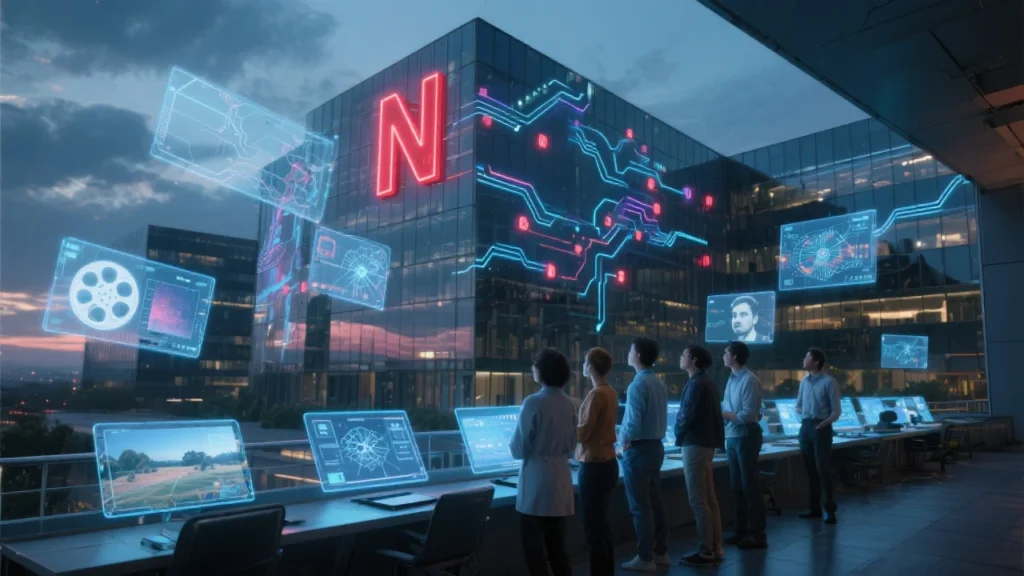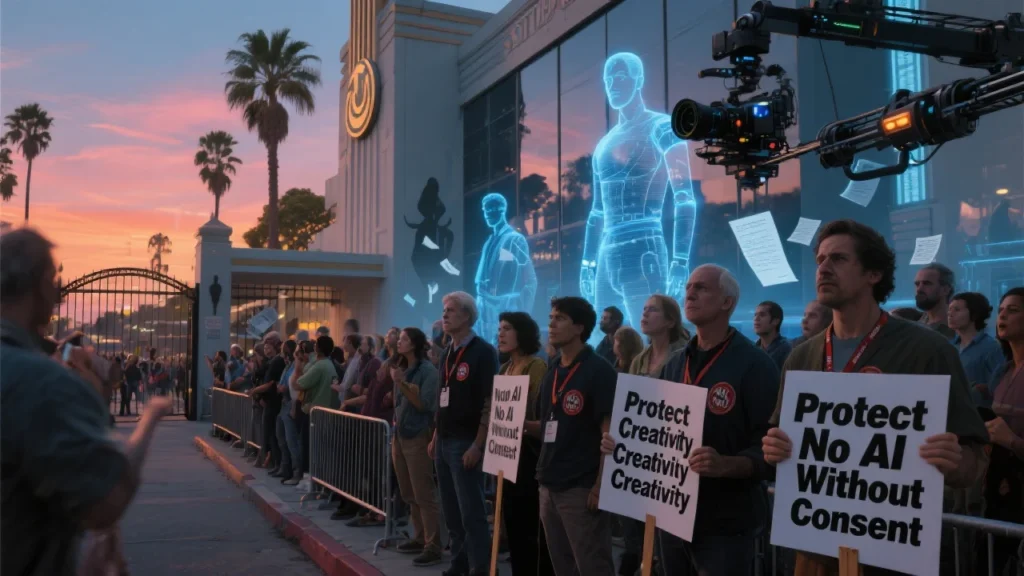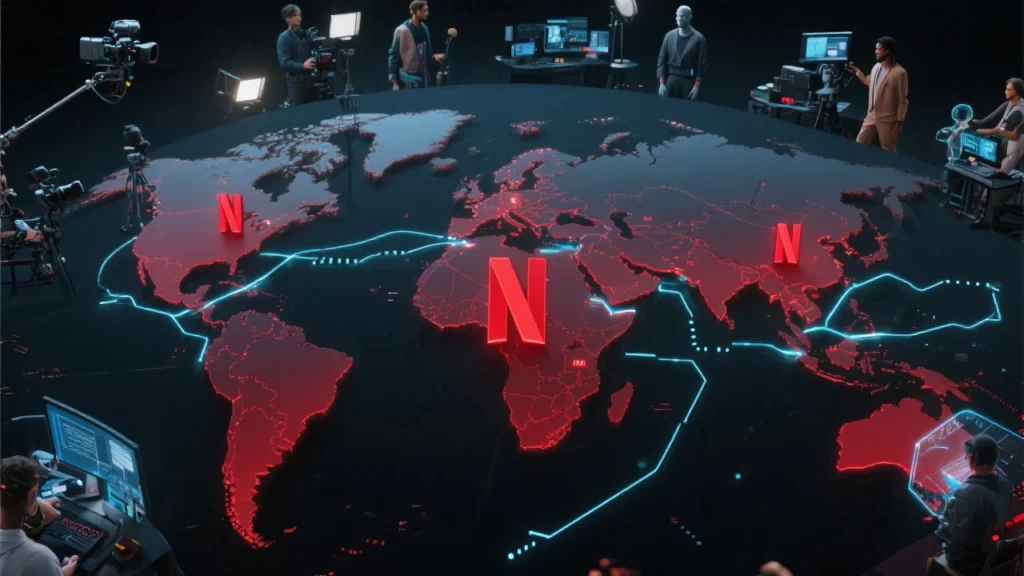
The streaming giant just dropped a bombshell. Netflix has officially published comprehensive guidelines for generative artificial intelligence use in content production. This isn’t just another corporate policy update it’s a game-changer that could reshape how the entire entertainment industry approaches AI technology.
The timing couldn’t be more critical. As AI tools become increasingly sophisticated and accessible, content creators worldwide are grappling with fundamental questions. How do we harness AI’s creative potential? Where do we draw ethical lines? What happens to human artistry in an AI-driven world?
Netflix’s answer comes in the form of detailed guidelines published on their Partner Help Center. These rules don’t just govern Netflix’s own productions they set expectations for every vendor, partner, and creative team working with the streaming platform.
The Wake-Up Call That Started It All
Remember “What Jennifer Did”? That 2024 true crime documentary sparked serious controversy when viewers discovered AI-generated images masquerading as real archival photos. The backlash was swift and brutal. Netflix learned the hard way that audiences don’t appreciate being deceived, especially when they’re seeking truth about real events.
The documentary stood out as a glaring example of AI’s potential to distort reality. In a genre where authenticity is paramount, using artificial images without disclosure violated viewer trust. The incident became a cautionary tale about AI’s misuse in factual content.
But the real catalyst came with “The Eternaut,” Netflix’s Argentinian sci-fi series. Co-CEO Ted Sarandos openly celebrated how AI helped create a building collapse scene in Buenos Aires. The visual effects sequence was completed 10 times faster than traditional methods would have allowed. More importantly? The cost savings made the shot feasible for the show’s budget.
That moment marked Netflix’s first official use of generative AI in final footage. It also signaled a new era was beginning. Sarandos described how Netflix’s Eyeline team partnered with creators using AI-powered tools. The result was remarkable speed and cost-effectiveness that traditional VFX workflows couldn’t match.
The success of “The Eternaut” demonstrated AI’s potential for enhancing storytelling without compromising quality. It showed how technology could democratize high-end visual effects, making ambitious scenes accessible to productions with smaller budgets.
Five Rules to Rule Them All
Netflix’s new guidelines aren’t suggestions they’re requirements. The company has established five core principles that production partners must follow when using generative AI tools. These principles form the foundation of responsible AI use in entertainment.
First Rule
Outputs cannot replicate copyrighted material or infringe on protected works. This seems obvious, but it’s surprisingly complex in practice. AI models often train on vast datasets that include copyrighted content. Netflix wants to avoid legal nightmares that could result from inadvertent infringement.
The challenge lies in AI’s “black box” nature. Many models don’t clearly indicate their training sources. This opacity makes it difficult to guarantee that outputs don’t contain copyrighted elements. Netflix’s rule forces partners to use more transparent AI tools or accept liability risks.
Second Rule
Generative tools cannot store, reuse, or train on production data. This protects Netflix’s proprietary content and ensures sensitive information doesn’t leak into AI training datasets. It’s a smart move considering how valuable unreleased content can be to competitors or bad actors.
This requirement effectively eliminates many consumer-grade AI tools from professional workflows. Most free AI services retain rights to user inputs for training purposes. Netflix’s rule pushes partners toward enterprise solutions with stronger data protection guarantees.
Third Rule
Netflix prefers enterprise-secured environments for AI tools. Security matters when you’re dealing with billion-dollar productions and confidential scripts. Consumer-grade AI tools often lack the robust protections needed for professional use.
Enterprise AI platforms typically offer features like data encryption, access controls, and audit trails. These capabilities are essential for maintaining the confidentiality that high-stakes productions require. The preference for enterprise tools reflects Netflix’s understanding of production security needs.
Fourth Rule
Generated material should be temporary, not part of final deliverables. This creates a clear distinction between AI-assisted ideation and AI-generated content that audiences actually see. It’s about maintaining creative authenticity while leveraging AI’s brainstorming capabilities.
This rule allows creators to use AI for exploration and concept development without compromising the final product’s human authenticity. It acknowledges AI’s value as a creative aid while preserving the primacy of human artistic vision.
Fifth Rule
AI cannot replace talent performances or union-covered work without consent. This directly addresses concerns raised during the 2023 Hollywood strikes. The Screen Actors Guild and Writers Guild fought hard for protections against AI replacement.
The rule recognizes that AI’s impact on employment is a central concern for creative professionals. By requiring consent for AI use in performance-related contexts, Netflix acknowledges workers’ rights while maintaining flexibility for legitimate AI applications.
When You Need Written Approval
Some AI uses automatically trigger Netflix’s approval process. The guidelines specify four categories that always require escalation and written approval before proceeding. These categories reflect the highest-risk applications of AI technology.
Using proprietary information or personal data requires escalation. This includes Netflix-owned materials like unreleased assets, scripts, or production images. It also covers personal data about cast and crew members. The rule prevents unauthorized use of sensitive information in AI training or generation.
Training models on artist work without clearance is forbidden. This addresses a major concern in the creative community about AI models trained on copyrighted artwork without permission. Netflix’s rule ensures that any custom AI training respects intellectual property rights.
Generating key creative elements like main characters needs written approval. This category recognizes that AI-generated core story elements could have significant legal and creative implications. Main characters, key visuals, and central fictional settings all fall under this requirement.
The guidelines get specific about talent enhancement scenarios. Creating digital replicas requires explicit consent from the affected performers. This rule directly addresses deepfake concerns and ensures that actors maintain control over their digital likenesses.
Significant alterations to performances need careful review. Even subtle changes can have legal implications, especially if they alter the emotional tone or intent of an actor’s work. Netflix’s rule ensures that performance modifications receive appropriate scrutiny.
Netflix also addresses ethical concerns about misleading content. AI-generated material that could be mistaken for real events is prohibited. The company learned from the “What Jennifer Did” controversy that audiences must trust what they see on screen.
The Hollywood Context

These guidelines emerge from a turbulent period in Hollywood. The 2023 dual strikes by SAG-AFTRA and the Writers Guild lasted four months. AI protections were central to union demands. Workers feared technology would eliminate jobs and devalue human creativity.
The strikes represented a watershed moment for AI in entertainment. For the first time, creative workers organized specifically around technology concerns. Their demands included protections against AI replacement and requirements for consent when AI uses their work.
Netflix operates in 190 countries, many beyond Hollywood union reach. This global scope makes the guidelines particularly significant. They establish standards that could influence international productions where union protections might not apply.
The international dimension adds complexity to AI governance in entertainment. Different countries have varying copyright laws, labor protections, and AI regulations. Netflix’s guidelines create a unified standard across diverse legal landscapes.
Industry insiders view these rules as Netflix’s attempt to lead responsibly. The company wants to embrace AI benefits while avoiding the pitfalls that have plagued other tech adoptions in entertainment. This leadership position could influence industry-wide practices.
Real-World Applications
The guidelines include a practical use case matrix that helps partners quickly assess their AI proposals. This matrix provides clear guidance for common scenarios, reducing uncertainty and streamlining the approval process.
Using AI for ideation and mood boards gets a green light. These low-risk applications help creators explore concepts without replacing human work. They represent AI’s value as a brainstorming tool rather than a content generator.
Background elements like signage or posters require judgment calls. Incidental items might be acceptable, but story-relevant elements need escalation. The distinction matters for legal and creative reasons, as prominent AI-generated elements carry higher risks.
Final character designs and key visuals always require approval. These elements impact legal rights and audience perception. They also potentially affect union roles, triggering additional protections for creative workers.
Talent replication scenarios demand the highest scrutiny. Re-aging actors or creating synthetic voices involves complex consent and legal review processes. The stakes are simply too high for casual implementation without proper safeguards.
The Technology Behind the Rules
Netflix’s approach reflects deep understanding of AI capabilities and limitations. Generative AI tools can rapidly create video, sound, text, and images. They’re powerful creative aids when used transparently and responsibly.
The company emphasizes enterprise-grade tools over consumer applications. These professional platforms offer better data protection and don’t train on user inputs. They’re essential for maintaining confidentiality in high-stakes productions.
Enterprise AI solutions typically include features like data residency controls, custom model training, and enhanced security measures. These capabilities justify their higher costs by providing the protection and control that professional productions require.
Custom workflows built from multiple AI tools must meet the same standards. Each step in the pipeline needs proper data protection and content integrity measures. Vendors working with Netflix must understand these requirements across their entire AI stack.
The guidelines acknowledge that AI technology is rapidly evolving. New tools emerge regularly with different capabilities and risks. Netflix’s framework is designed to adapt to these changes while maintaining consistent protection standards.
Industry Reactions and Implications
Creative professionals have mixed reactions to Netflix’s guidelines. Some praise the efficiency gains AI enables, particularly in visual effects and pre-production planning. Others worry about job displacement and the erosion of creative authenticity.
The debate reflects broader tensions about technology’s role in creative industries. Optimists see AI as a democratizing force that makes high-end production techniques accessible to smaller creators. Pessimists fear it will devalue human creativity and eliminate jobs.
Union representatives haven’t officially responded to the new guidelines yet. Their silence speaks volumes about the delicate nature of AI negotiations. The rules appear designed to address union concerns while enabling innovation.
The guidelines could influence ongoing labor negotiations across the industry. Other studios may adopt similar frameworks to demonstrate their commitment to responsible AI use. This could become a competitive advantage in attracting talent.
Competitors are watching Netflix’s approach closely. Sources suggest other studios are discussing similar policies. Netflix’s guidelines could become an industry template for responsible AI use, similar to how their streaming model influenced the entire entertainment landscape.
The Business Case for AI
Netflix’s embrace of AI isn’t just about creativity it’s about economics. The “Eternaut” building collapse scene demonstrates AI’s cost-effectiveness. Traditional visual effects would have been prohibitively expensive for the show’s budget.
This economic dimension is crucial for understanding AI’s appeal in entertainment. Production costs continue rising while audiences demand higher quality content. AI offers a potential solution by making expensive techniques more affordable.
Co-CEO Ted Sarandos emphasizes that AI enables better storytelling, not just cheaper production. This framing positions technology as a creative enhancer rather than a cost-cutting tool. It’s a crucial distinction for industry acceptance among creative professionals.
The company has used AI in personalization and recommendations for two decades. This experience gives Netflix credibility when establishing content production guidelines. They understand both AI’s potential and its pitfalls from practical experience.
Netflix’s long history with AI also provides valuable lessons about implementation challenges. The company has learned how to integrate AI tools while maintaining quality and user trust. These lessons inform their approach to content production AI.
Looking Forward: Challenges and Opportunities
Enforcement remains a key question. How will Netflix monitor compliance across global productions? The company likely will use production audits and possibly its own AI tools for oversight. This creates an interesting meta-application of AI to govern AI use.
The scale of Netflix’s operations makes manual compliance monitoring impractical. Automated systems could help detect unauthorized AI use or flag potential violations. However, such systems would need careful calibration to avoid false positives.
Artist advocates express skepticism about the guidelines’ effectiveness. Visual effects professionals point to cases where AI models exploit creative work without proper compensation. Netflix’s rules aim to prevent such issues, but enforcement will be crucial.
The guidelines position Netflix as an industry leader in responsible AI adoption. This leadership could attract talent and partners who value ethical technology use. It’s a competitive advantage in an increasingly AI-driven landscape.
However, leadership also brings responsibility. Netflix’s approach will be scrutinized by regulators, unions, and competitors. Any failures in implementation could undermine the company’s credibility and influence future AI governance efforts.
The Global Perspective
Netflix’s international reach adds complexity to AI governance. Different countries have varying approaches to AI regulation, copyright law, and labor protection. The guidelines must work across diverse legal and cultural contexts.
European Union AI regulations are becoming increasingly strict. Netflix’s guidelines appear designed to comply with emerging EU requirements while maintaining operational flexibility. This proactive approach could prevent future regulatory conflicts.
Asian markets present different challenges, with varying attitudes toward AI use and intellectual property protection. Netflix’s guidelines provide a consistent framework that can adapt to local requirements while maintaining global standards.
The company’s approach could influence international AI governance discussions. As governments develop AI regulations, Netflix’s practical experience could inform policy decisions. This positions the company as a thought leader beyond just entertainment.
The Bigger Picture

Netflix’s AI guidelines represent more than corporate policy they’re a blueprint for the entertainment industry’s AI future. The rules balance innovation with responsibility, efficiency with ethics, and technological capability with human values.
The streaming giant learned from early missteps like “What Jennifer Did.” These guidelines show how companies can course-correct and establish better practices. It’s a model other entertainment companies will likely follow as they navigate their own AI adoption journeys.
As AI technology continues advancing, these guidelines will probably evolve. Netflix has created a framework that can adapt to new capabilities and challenges. That flexibility will be crucial as the AI landscape changes rapidly.
The entertainment industry stands at a crossroads. AI offers tremendous creative and economic opportunities. But it also poses risks to jobs, authenticity, and audience trust. Netflix’s guidelines show one path forward embracing technology while protecting human creativity.
Whether other companies follow Netflix’s lead remains to be seen. But these guidelines have set a new standard for responsible AI use in entertainment. The industry will be watching to see how well they work in practice and whether they successfully balance innovation with protection.
The ultimate test will be in the content itself. Will Netflix’s AI-assisted productions maintain the quality and authenticity that audiences expect? Will the guidelines successfully prevent the kind of controversies that damaged trust in the past? These questions will determine whether Netflix’s approach becomes the industry standard or just another corporate policy experiment.
Sources
- The Verge – Netflix wants its partners to follow these rules when using gen AI
- StreamTV Insider – Netflix publishes partner guidelines for GenAI use in content production
- WebProNews – Netflix Releases Ethical AI Guidelines for Content Production
- Netflix Partner Help Center – Using Generative AI in Content Production









